Carcassonne is one of the world's most magical places, a double-walled medieval city on a hill with fortified towers rising tall and pointed. There cannot be very many places in the world that produce so profound an effect upon the imagination, and the sense of beauty and history as the old walled town of Carcassonne.
Carcassonne is one of the world's most magical places, a double-walled medieval city on a hill with fortified towers rising tall and pointed. There cannot be very many places in the world that produce so profound an effect upon the imagination, and the sense of beauty and history as the old walled town of Carcassonne.
This is such an important historic landmark that the castle and entire Old Town are on the UNESCO list of World Heritage Sites.
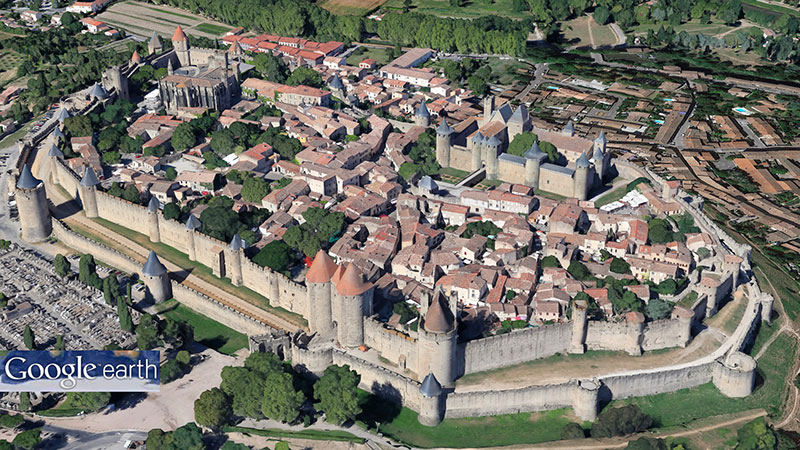
This largest medieval fortress in France consists of concentric circles of two outer stone walls with 53 towers and barbicans to prevent attack, surrounding a well-preserved village. There's something about castles like this that appeals to the kid in all of us and really fires up the romance of the past.
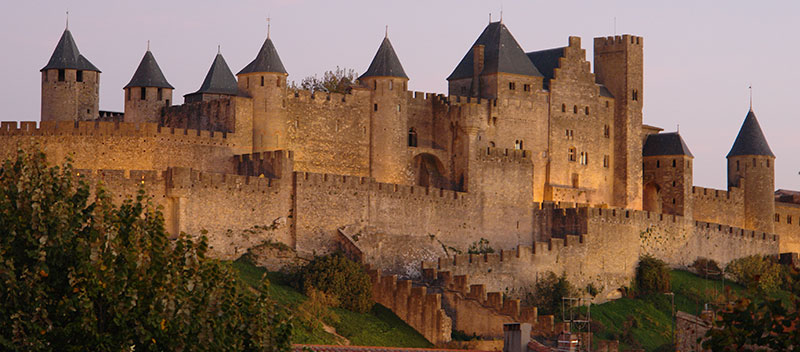
One of the most rewarding activities is strolling about on the narrow cobblestone lanes within the walled village, where no cars are allowed. It's not a large town by any means, just one-quarter mile long (500 meters), so it's easy to walk within the walled area and see nearly everything in a day.
-04.jpg)
Two main and several side lanes make up the entire plan, yet there is enough to keep you amused, admiring the historic buildings, looking at the shops and going to the museum inside the castle.
-04.jpg)
There is one delightful location in the heart of the Old Town that is truly the heart and soul of this place, Place Marcou, with many outdoor terrace restaurants in a tree-shaded plaza. The food is good, especially the local specialty of cassolette, atmosphere is beyond perfect, and drinks will further enhance the ambience.
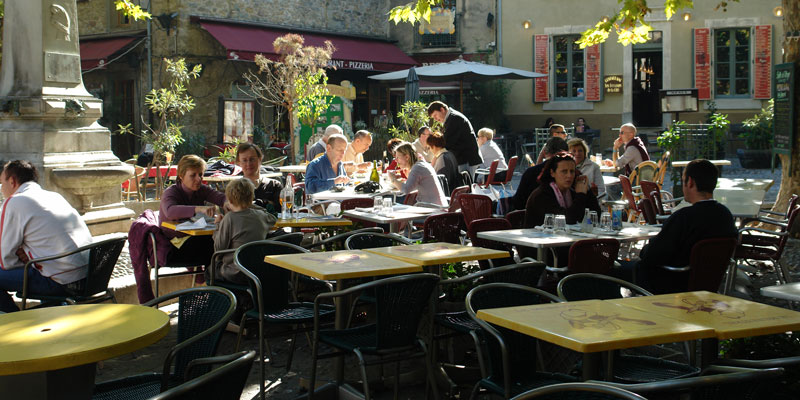
This one spot is reason enough to spend at least one night in the village to enjoy this evening atmosphere after the day-trippers have departed. Or come for lunch if that's convenient, you will love, love, love it.
Actually the whole village functions as a large fortress, with the double layer of walls running all the way around it, and castle in the center. The citadel was built on top of a hill, with some cliffs around offering natural supplements to the defensive walls.
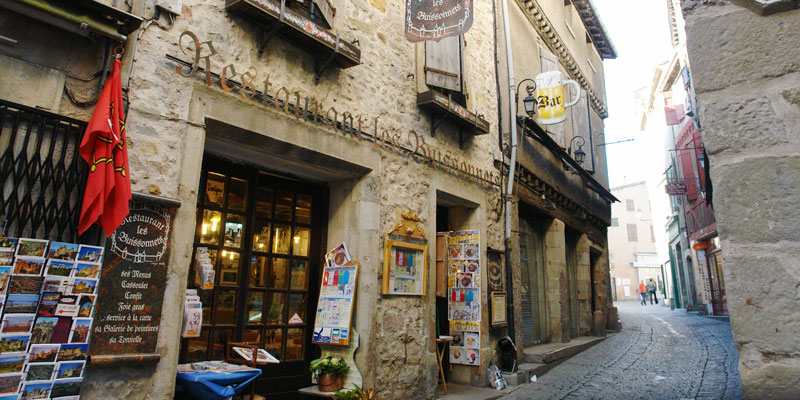
There is a functioning town within the walls, with shops, several small hotels, and 50 homes for the local residents as well, with a small plaza in the center hosting some outdoor terrace restaurants, and a vast pedestrian zone that you want to explore. Today’s 100 residents are mostly the descendants of many generations of families who have been living here for centuries.
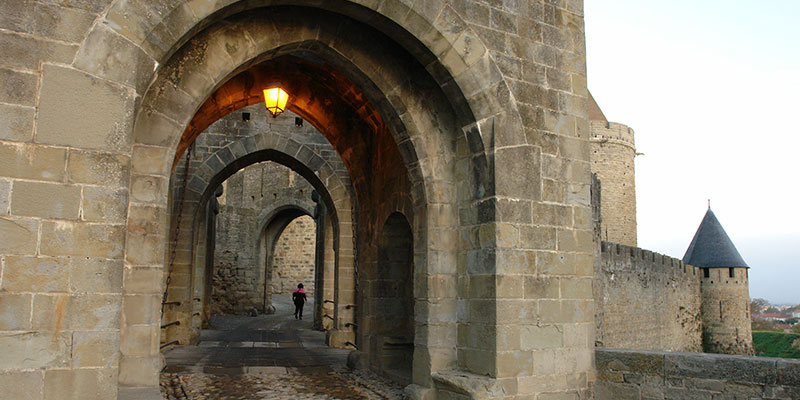
The main gate leading into Carcassonne is the Narbonne gate. It is a fortified gate with the barbican reaching out from the wall to help defend the gate, because the gate would be a vulnerable part of the town. That's where the invaders would try to break down the door and get in. But this Narbonne gate has walls and battlements, forming a protected barrier. This complicated entrance solved the problem of how do you get through a wall while keeping the attackers out.
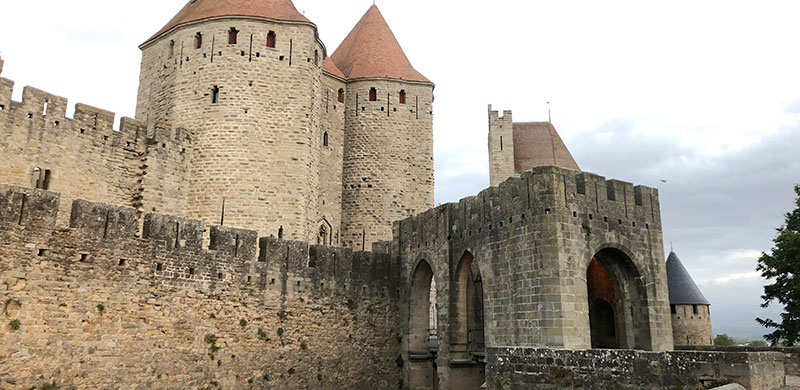
A side view of the Narbonne Gate shows the fortified barbican extending out, which is protecting a drawbridge that can be raised to further strengthen the defenses. The big tower up behind it gave a perch for bowmen to shoot down on the enemies. There are trapdoors in the gate that can drop boiling oil, and rocks and boulders onto people trying to attack. They can close the gates, drop a portcullis, and trap the invaders inside what becomes a shooting gallery, and really defend this castle.
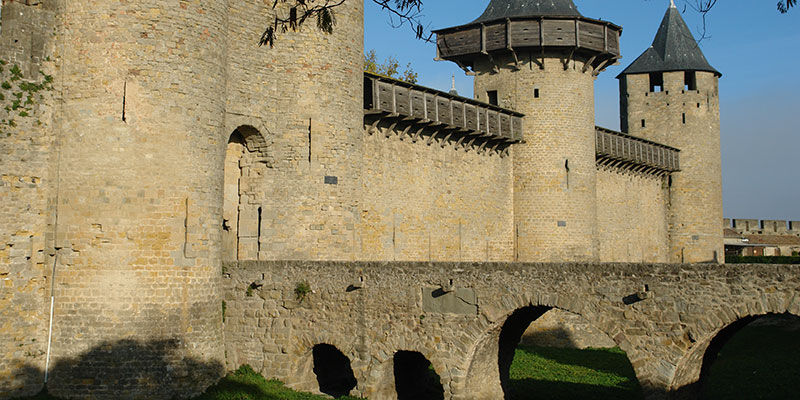
Château Comtal is the castle inside the walled fortress, with a dry moat around it, crossed by a stone bridge leading to the entrance. The Count's Castle is the "keep" or strong house in the center of the village, and is open as a fascinating museum of history. The front gate is surrounded by a semicircular barbican wall providing more defense.
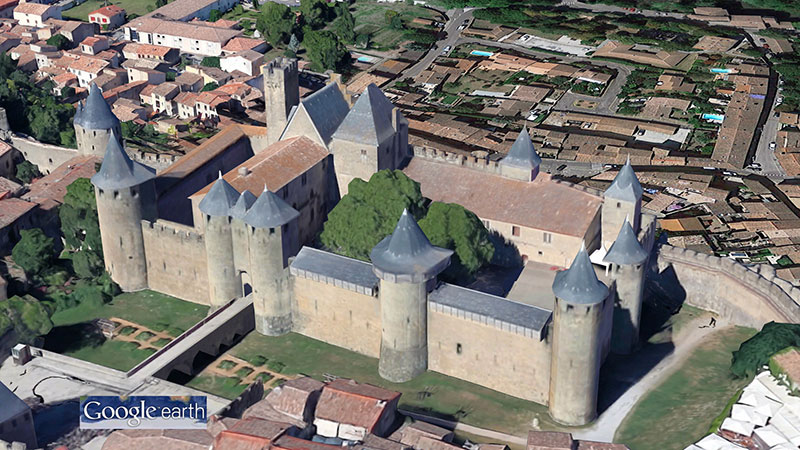
A Google Earth view shows the overall castle shape with its central courtyards and fortified walls and towers. It's believed that this castle was first built from about the year 1130, which puts it deep into the Middle Ages, and then it was occupied for hundreds of years as the stronghold at the center of this amazing village. A ruling lord occupied Carcassonne until the 15th century.
-04a.jpg)
Enjoy the view from the terrace in front and notice those wooden extensions from the top of the wall. They enabled defenders to drop rocks, burning oil and shoot arrows at any attackers trying to get up the walls. This was the first castle to use such wooden platforms.
-04.jpg)
Once you pay the small admission fee you're welcome to enjoy the various courtyards and also enter inside the castle where they have a historical museum. We are later going to walk along the castle wall, which is included in the admission fee for the castle.
-04.jpg)
The Arcade Room of the castle has a Gothic window frame as well as architectural fragments of columns. The next room was called the Round Room because of the barrel-vaulted ceiling. It has a 16th century crucifix and original wall mural that dates back to the 12th century depicting a battle between the Christians and Muslims -- part of the ongoing struggle in this part of Europe in the Middle Ages.
-04.jpg)
The next room over is called the Romanesque Room with a washbasin in the middle that dates back to the 12th century. All around there are coffins, stone sarcophagi depicting some Christian iconography, and more architectural fragments. The original stone framing of the windows and doorframes are visible there.
-04.jpg)
There's a wonderful model of the castle itself showing the extent of the wall around the village.
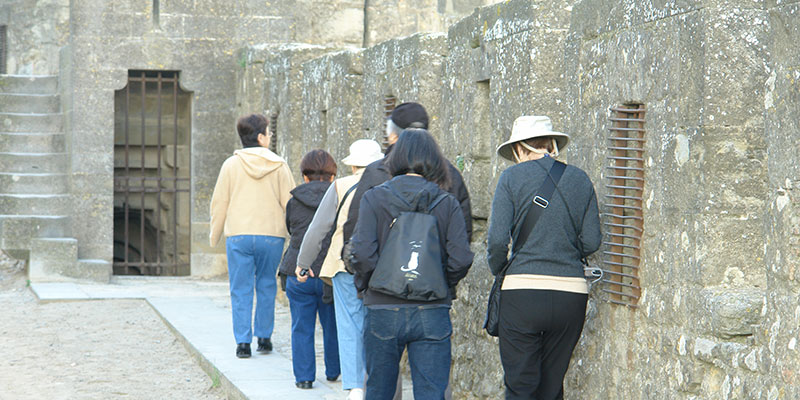
We are going to take a walk all the way around the wall that encircles the fortified town of Carcassonne, then fill you in on the history of this most unusual place. There's a tall inner wall, and a lower outer wall providing two layers of protection for the old medieval city, with big towers providing the defenders fortified positions to fire at the attackers. The spectacular wall is the defining monument of the city, created by the medieval defenders of the town. You get the feeling that somehow you are back in the Middle Ages when these walls were built, in the 12th and 13th centuries.
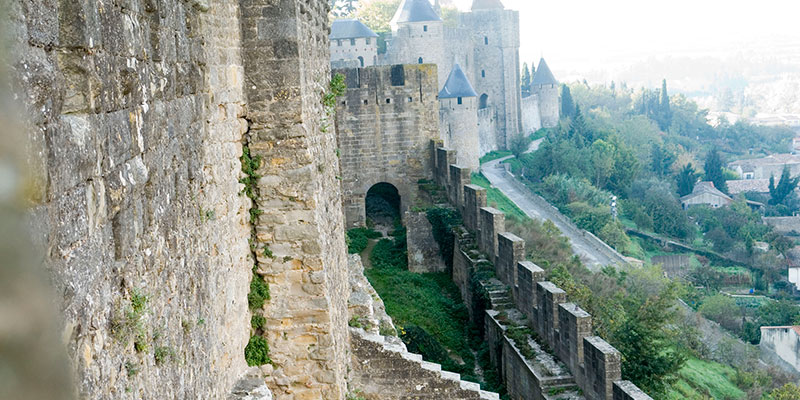
One of the most beautiful parts of the outer castle walls is the embattlement that connects the inner wall with the outer wall, with two beautiful Gothic arches that join it all together in a magnificent ensemble, located on the west side between the Castle and the Aude Gate.
The wall has many towers, which had a variety of functions -- but mostly of course were for defense, with armed soldiers inside armed with bows and arrows. There are usually four floors inside each tower with slits in the tower walls so that they would be protected while firing their arrows at the enemy attackers.
-04.jpg)
The outer wall is more than 1600 meters in length, the inner one 1200 meters. The Visigoths built the whole of the north part on the ruins of Roman fortifications, which are still visible at several points. There are only two entrances, the Porte de l'Aude, to the west, beyond the fortress, and the Porte Narbonnaise, to the east.
-04.jpg)
As you walk along on top of the wall you also get nice views looking into the fortified village, with parapets and roofs. We see a community of homes, a church, and a strange structure in the middle, with two parallel walls going down the hill.
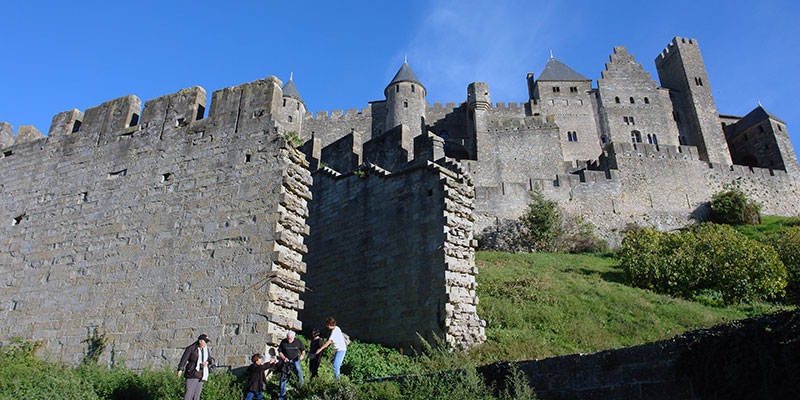
They had a fortified walkway that came down from the old town with the walls on both sides of it. That enabled them to walk down to the river and get water and be protected at the same time from any sort of attack, any ambush that might spring up. Of course, they had a water supply up in the town, but more often they would also come down to the river to get more water. You can't really walk up there nowadays, it's a dead-end, doesn't go anywhere, but it's nice to look at it from down below.
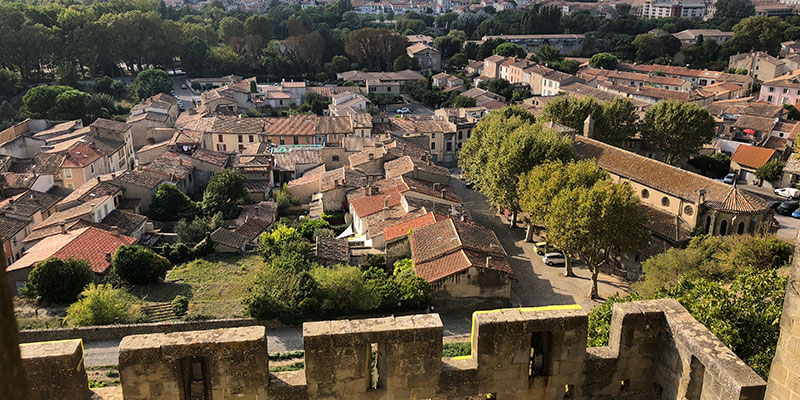
Looking outside the walls you see a lovely view looking out on the newer side of town down below that we shall walk to later. You’ll see views of extensive vineyards around this hilltop village, producing some of the excellent wines of the Languedoc.
At this section of the wall, we have a good view of the church of the old town, the Basilica of St Nazaire, described below. Historical pageants are occasionally presented at the outdoor theater during the high season. There are some staircases along this wall, but really it's not too strenuous. Anybody can take this walk.

We're also going to walk in the level space between the inner and outer walls, at this point exiting the paid section of the wall. The following part is open to all for free. This public area between the inner and outer walls functioned something like a moat, although it never had water, to further reinforce the protective barrier keeping out potential invaders.
It is a fascinating stretch of wall because we're walking on that lower outer wall, just in front of the high bastion, and in between is the open area they called the liste, which was a dry moat, part of the defensive fortifications, for one more ring of protection, and sometimes used for storage of their weapons. During times of peace, they would hold jousting tournaments here, with knights on horseback and lances trying to knock each other down. It was the days of chivalry. Both sets of walls underwent reconstruction during the final phase of building in the late 13th century, with more towers added and enlarged.
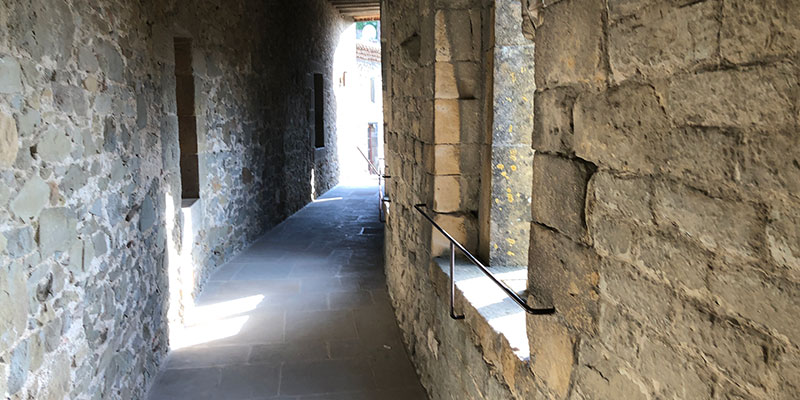
That does complete the main segment of this walk around the walls of Carcassonne, and from here you could head back through the Narbonne Gate, up the main little shopping lane of town. It will lead you back to the castle, but there is one more part of the wall that you can visit. We're going to continue around the final section on the north side, where we are going to see some evidence of the early Roman wall.

Once again we have an outer wall, and then a clear space, and a higher inner wall, with an interesting gate leading inside the old town. It's a medieval feature which is believed to be where the ancient Roman gate was also located, as seen here from inside the wall.
These big walls are from the medieval period, but they are built on a foundation of earlier Roman walls that date back to the third and fourth centuries, as proven by that unique Roman technique of using brick in construction of their stone walls. The medieval builders inserted foundations underneath the Roman wall to stabilize them.
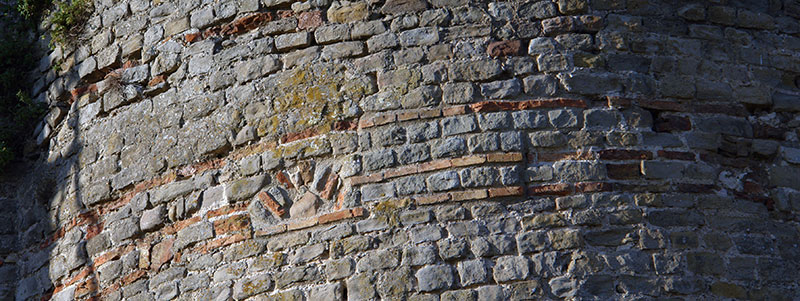
The original Roman walls were three meters thick can 6 to 8 meters, characteristic of the late Roman style with rubble cores faced with stone and bricks on a concrete foundation. This route brings us back around to the north end of the walls where we get some nice views looking out across the rest of Carcassonne. We are approaching the end of the walk as we arrive back at the castle. We're walking through some foundations and arches that used to hold up one of the banquet rooms of the castle. It's a heavy medieval kind of Gothic architecture with those pointed arches.
The oldest building within the walls is the Basilica of St. Nazaire and St. Celse, one of the most exquisitely beautiful churches in the south of France. It had been a cathedral when it was built in the 11th century. The style of this church is Romanesque with later Gothic elements added, including the nave, with its pointed arches, and the spectacular stained-glass windows in the apse and grand rose windows in the transepts.
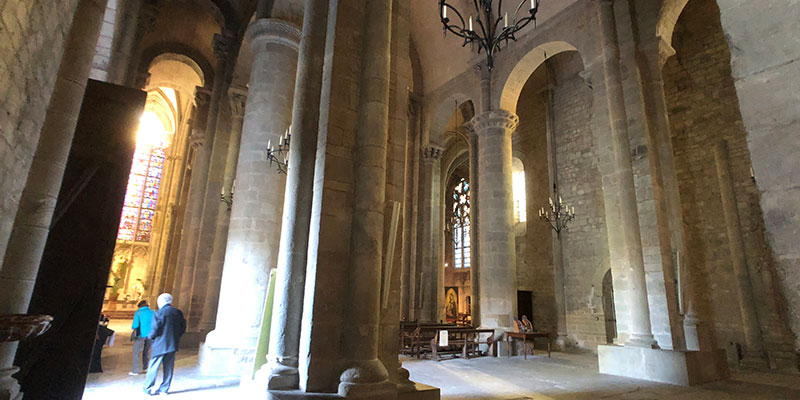
It has a fine Romanesque nave consecrated by Pope Urban II in 1096, with its west end designed for defense, after the customary manner in the south. It is supported by massive piers, alternately round and square.
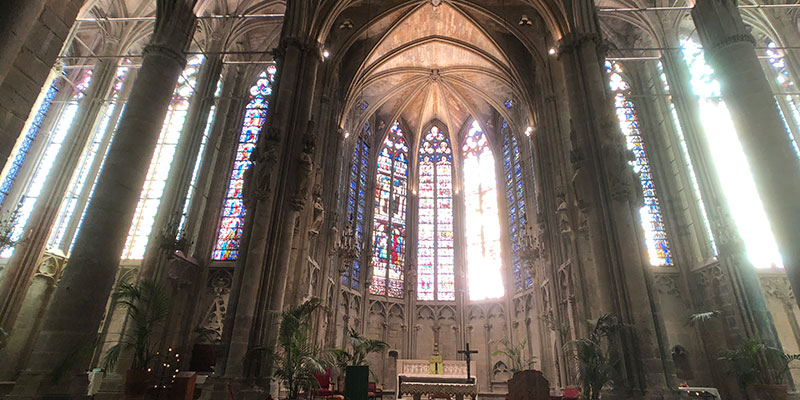
The nave, in the Romanesque style of the 12th cent., with Gothic side-chapels, is heavy and massive when contrasted with the transept and the choir, both of which are splendid erections of the 14th century.
-04.jpg)
Its towers are solid masses of heavy stone; instead of spires, there are crenellations; instead of graceful flying buttresses at the sides, there are solid, upright supports on the firm, plain sidewalls. This is the true old Romanesque.
Carcassonne certainly ranks right up there in the world's top sites, so it does get extremely busy with tourists. During the day there are no cars allowed inside the fortified town. But in the morning, it's time for the delivery vehicles and the service vehicles, and they come driving in. It's almost like rush hour, a parade of traffic, about 9 o'clock in the morning.
When you're visiting Carcassonne you want to be sure to leave the confines of the medieval village up on the hill and come down into the New Town, called the Bastide, which is charming in itself and offers the best view looking back up the hill at the citadel. To walk down the hill to the New Town, exit from the Aude Gate on the west side of the village.The round-trip walk is just a total of the three kilometers, which you can easily do it in under an hour, relaxing and enjoying the views. Most of it is quite level. However you will want to spend some time strolling around in the New Town.
-04.jpg)
Shortly after leaving the fortress you get a classic viewpoint looking back up at the massive walls, gate structure and castle towers. Continue down and you cross the river on the old, pedestrian bridge.
-04.jpg)
Some little side canals branch off from the river at this point as well and there is a small part of the town down below the castle ramparts that's a connection between the new town and the old town which provide additional lovely views. In 15 minutes you reach flat land just below the hill, and this too is a fascinating place to explore.
-04.jpg)
Upon entering the New Town one of the first sights is the pedestrian mall, Rue Georges Clemenceau, runs for a mile through the center lined with shops and cafes, with branching side streets containing many more stores and sights. There is often a produce market happening in the main square, with cafes all around it.
-04.jpg)
-04.jpg)
King Louis -- St. Louis -- who is considered one of the greatest heroes in the nation's past, built this modern part of town back in the 13th century. This lower town became even more important than the fortified village in the following couple hundred years, as the region's economic center. They were noted for fabric production back in the 13th through 15th centuries, and then the main focus shifted to production of wine. There are a lot of vineyards in the area which produce wonderful grapes, and there was also farming for wheat, vegetables and dairy.
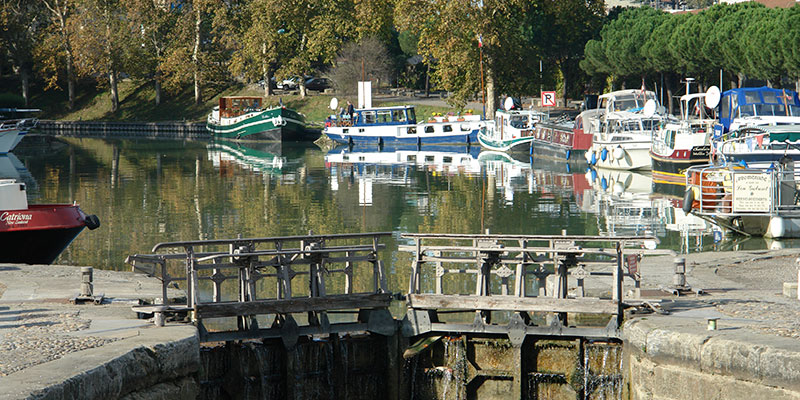
The Canal du Midi was built through here in the late 17th century and runs for a couple of hundred miles, part of a system that connects the Mediterranean with the Atlantic Ocean. With the Canal du Midi Carcassonne became even more important as a trading center. The canal is also a UNESCO World Heritage sites.
-04.jpg)
The Lower Town, which is well built and regularly laid out, is encircled by green and shady boulevards. A long street opposite the station, beyond the Canal du Midi, traverses the whole town, passing the Place aux Herbes in the center. The Place aux Herbes to which the Rue du Port leads from St. Vincent, is planted with fine plane-trees and contains a marble Fountain of the 18th century with a figure of Neptune, by Baratta.
-04.jpg)
One gate from the original wall has been preserved, which leads to the Art Deco town hall. There was a fortified wall around the new town also, but it was pulled down back in the 18th century when they had no further worries about invasion due to the nation's stability under Louis XIV. Gardens and parks have replaced the wall, which make a lovely walk as we head back up towards the hill, stopping for the fabulous twilight view of the citadel, ablaze with spotlights and the sunset sky.

Early evening is also an excellent time to explore the New Town, and when looking back up at the castle, you will enjoy an astonishing view of the fortress bathed in golden light.
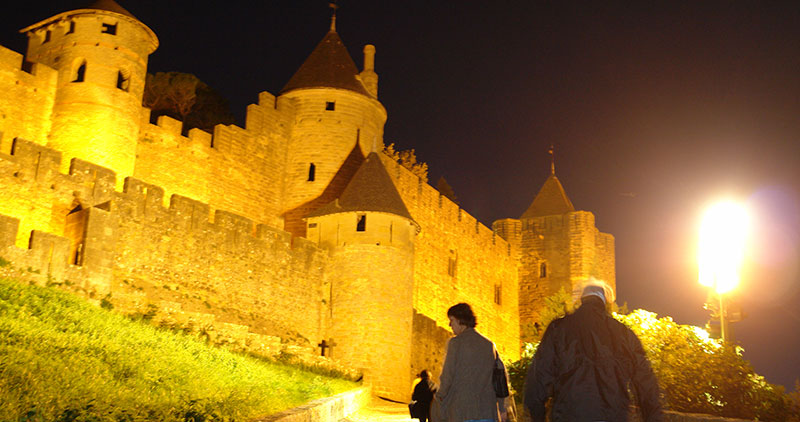
Return up the hill into the walled village to enjoy the special combination light from the twilight sky and street lights shining on the cobbled walkways. Several excellent restaurants in the old village offer tempting local cuisine to finish off your night. The cafés and restaurants will be open and you can have a meal or have a drink. It's all perfectly safe to be strolling whether it's late in the evening or early in the morning, which are magical time with that special lighting, and because there are fewer people around.
If you are spending the night there are several excellent hotels to pick from inside the walled village, including the five-star Hôtel de la Cité, which is described in the next video. A less-expensive, but excellent hotel is the Best Western le Donjon, close to the castle.
No one is quite sure when people first arrived at this location, but the first signs of settlement in this region have been archaeologically dated to about 3500 BC. The hill became an important trading place in the sixth century BC on this rocky spur overlooking the valley of the Aude River, straddling the ancient routes linking the Atlantic with the Mediterranean, and the Iberian Peninsula – a very strategic location.
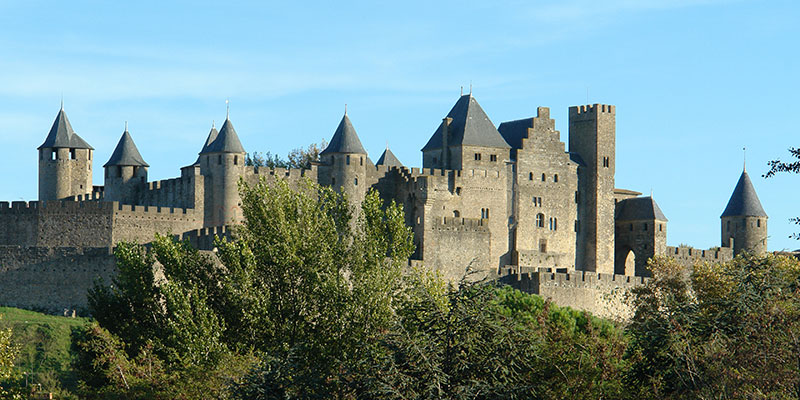
The Romans occupied this land in 122 B.C. when they conquered the south of France, and set up a fortified town on the hilltop and built the first walls. The place commanded one of the great roads into Spain, critical to maintaining control of the region. They occupied the area right up until the collapse of their civilization, in the late 400s. The main part of the lower courses of the northern wall dates from Roman times.
With the departure of Rome, the Visigoths took over and they occupied Carcassonne from 460 until 725 A.D. The Romans officially ceded Septimania to the Visigothic king Theodoric who had held Carcassonne since 453; he built more fortifications at Carcassonne, which was a frontier post on the northern marches.
-04.jpg)
This castle was first built from the early 12th-century, but the fortifications have a much longer history. Most of the Visigoth towers that are still erect are seated upon Roman foundations which appear to have been formed hastily, probably at the moment of the Frankish invasion. The Visigoth creators of these solid defenses held Carcassonne and the neighboring country, in which they had established their kingdom of Septimania, till the year 713, during which Carcassonne was a place of major importance. They were expelled by the Moors of Spain, who ushered in a lackluster four centuries, of which no traces remain. They had come up from Africa and already occupied Spain and were moving into southern Europe, but did not get much beyond Carcassonne. These Saracens, as they were called, were pushed out by the Francs, the ancestors of today's French. Carcassonne reached another climax in the 11th - 13th centuries, when it was ruled by a series of viscounts, the Trencavels.
-04.jpg)
Carcassonne became famous for its role in the Albigensian Crusades where the city was a stronghold of a Christian religious sect called the Cathars. They were Christians but considered heretics by the church in Rome. Cathars were opposed to the Roman church and had their own sacraments and bishops and did not believe that Jesus was sent to bring redemption to the human race.
These Cathars beliefs were not acceptable to the church and so Pope Innocent the Third recalled his Crusaders from the Holy Land to go and fight against his own kindred. Heretics at home, he held, were more dangerous than infidels abroad.
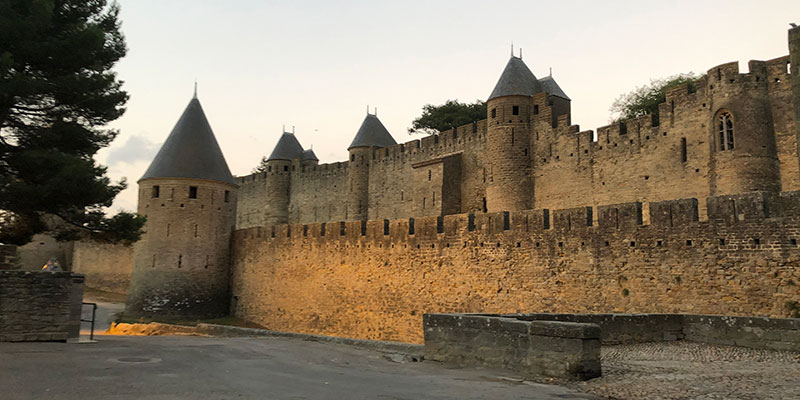
In August 1209 the crusading army of the Papal Legate, Abbot Arnaud Amalric, attacked and forced its citizens to surrender. The pope’s invasion was led by a cruel and remorseless Simon de Montfort, who is the only attacker who ever conquered Carcassonne. He flooded this fair region with blood. Heretics at home were considered more dangerous than infidels abroad…a familiar refrain of tyrants, it sounds familiar today. The crusading army forced the citizens to surrender and leave their city.
The former Cathar leader of the city, Raimond Trencavel, was forced into exile and rallied his troops to stage a counterattack to retake his city, which failed. He was defeated, captured, thrown in the dungeon, where he later died in the basement of his own castle.
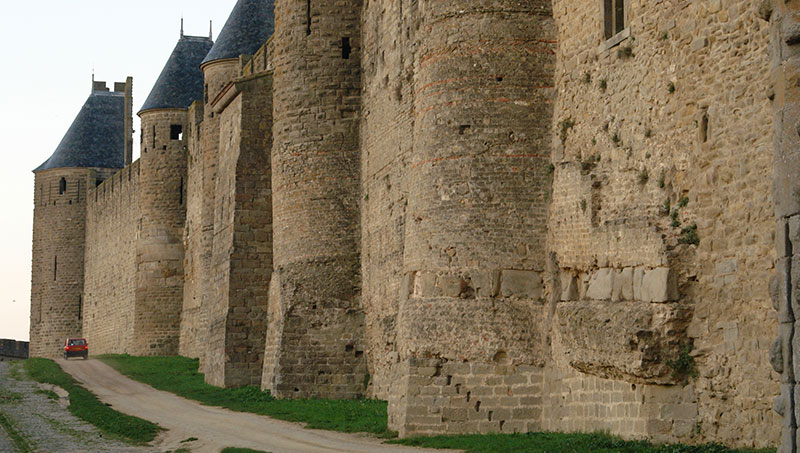
Simon de Montfort, Earl of Leicester, was appointed the new viscount. This cruel and remorseless right hand of the Pope flooded the region with enemy blood in a rampant campaign of death and destruction. De Montfort was killed on June 20th, 1218, by a stone flung from the walls of Toulouse, which he had been unsuccessfully besieging for nine months.
The victorious French King Louis IX and his successor Philip the Bold took full control of the castle in the name of the Pope, and by the mid-13th century they built the second wall, the outer rampart which made the fortress impregnable, and the castle never suffered another defeat in battle from that time on.
-04.jpg)
Carcassonne was one of the bulwarks of their kingdom on the Spanish quarter; and from this time forth, being regarded as impregnable, the place had nothing to fear. It was not even attacked; and when, in 1355, Edward the Black Prince marched into it, the inhabitants had opened the gates to the conqueror before whom all Languedoc was prostrate.
In 1659, the Treaty of the Pyrenees transferred the border province of Roussillon to France, and Carcassonne's military significance was reduced. Fortifications were abandoned, and the city became Languedoc's manufacturing center, concentrating on the woolen textile industry and wine production. It remained so until the Ottoman market collapsed at the end of the eighteenth century, and increased competition from abroad, thereafter reverting to a country town. It was forgotten and left to decay.
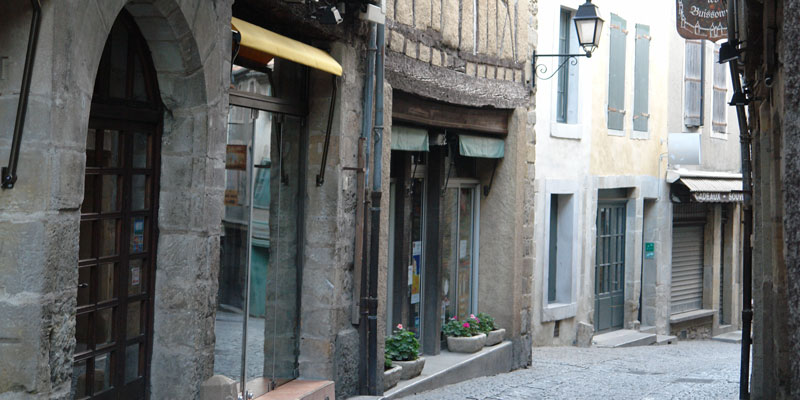
In mid 19th century it was so run down the government decided to demolish the entire town, but preservationists rose up to its defense and the village was spared. It was then renewed in 1850-1879 by Viollet-le-Duc, who considered them the most complete and the most formidable example in Europe of fortifications of the 6th - 13th centuries.
Tourists began to arrive and enjoy it early in the 20th century, and since then, its popularity has constantly grown, with currently over 2 million visitors in the average year, the second-most popular historic monument in France, after Mont St Michel, becoming one of the world's great historic sites.
-04.jpg)